The United States will begin deploying long-range and hypersonic weapons in Germany in 2026
Washington will begin deploying long-range weapons in Germany in 2026. We are talking about SM-6 anti-aircraft missiles, Tomahawk subsonic long-range cruise missiles and hypersonic weapons under development. Last week, Putin said that if American missile systems "appear somewhere," Russia can respond in a mirror way.
The United States will begin "sporadically" deploying new longer-range fire weapons, including hypersonic weapons, in Germany, according to a joint statement from Washington and Berlin. The weapon will be deployed in 2026, and subsequently it is planned to permanently deploy it on the territory of Germany.
Thus, the American side demonstrates Washington's commitment to NATO to European countries, the statement says.
The SM-6 is an American anti-aircraft missile equipped with an active homing head and capable of hitting targets beyond the radio horizon. Its maximum flight range is about 450 km. The Tomahawk is a family of long-range cruise missiles in service with the United States since 1983. The missile has several modifications, and its flight range reaches 5,500 km.
It is not known what kind of hypersonic weapons the United States intends to deploy in Germany, currently only Russia and China have such weapons. In March, the US Air Force announced the successful test of the AGM-183 hypersonic air-to-ground missile, and earlier in the same month, the Talon-A (TA-1) hypersonic aircraft, developed by Stratolaunch LLC under contract with the US Navy, was tested .
"The right to act in a mirror manner"
Russian President Vladimir Putin said on July 4 that Moscow could mirror the deployment of American medium- and shorter-range weapons. He recalled that the Russian Federation had a ban on the possible deployment of such weapons until other countries announced plans to deploy such missile systems.
In addition, the Russian president stressed that Moscow considers itself entitled to begin the development and production of intermediate-range and shorter-range missile systems against the background of the US withdrawal from the treaty on the Elimination of Intermediate-Range and Shorter-Range Missiles (INF).
"I said that in connection with the withdrawal of the United States from this treaty and the announcement that they are starting to start production, we also consider ourselves entitled to start development, and in the future production," he said, noting that the leadership of the Russian industry has already received instructions to start production of such weapons.
Long-range missiles
The agreement on the elimination of intermediate-range and Shorter-range missiles was signed in 1987 by Mikhail Gorbachev, General Secretary of the Central Committee of the CPSU, and US President Ronald Reagan. The treaty proposed to destroy the existing land-based ballistic and cruise missiles with a range of 500-1000 km (shorter) and 1000-5500 km (medium), as well as to abandon their further production and deployment.
In 2007, Moscow accused Washington of violating the agreement, since American missile defense systems (ABM) were installed in Eastern Europe, the launchers of which can also be used for INF. In 2014, the United States accused Russia of testing a cruise missile with a range of over 500 km.
Washington unilaterally suspended the fulfillment of obligations under the INF Treaty in early 2019 under the presidency of Donald Trump. The American leader then called the development and deployment of banned missile systems by Russia the reason for withdrawing from the agreement.
After that, the Russian president, by his decree, suspended the INF Treaty for Russia as well.
Anastasia Novikova

